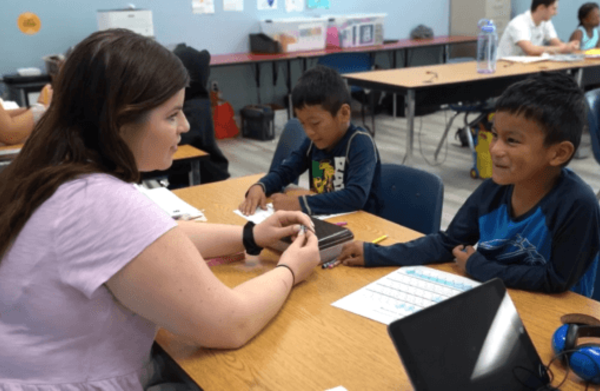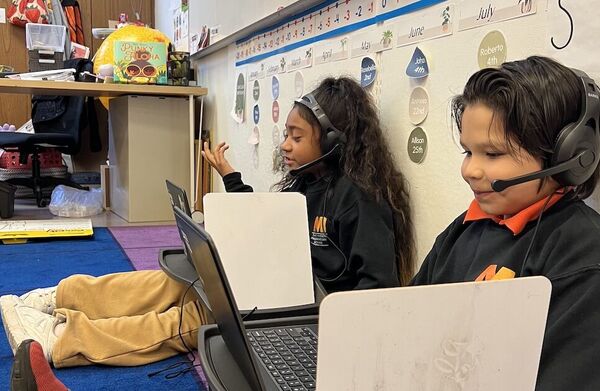Posted on
Activists are calling for a return to bipartisan education reform – we’re proving it’s possible.
Category: Policy and Advocacy
Congresswoman Lee represents Nevada’s 3rd Congressional District and Congressman D’Esposito represents New York’s 4th Congressional District.
“Our Nation is at risk.”
This sobering conclusion by the Reagan Presidential Administration, galvanized more than four decades of educational reform. Currently, America’s already distressed educational system is further hamstrung by the complexities of recovering and accelerating post-pandemic learning, deepening disparities in access to educational resources, endless line graphs detailing teacher shortages, and the rapidly evolving role of A.I. in the classroom.
America’s students and teachers remain at risk.
Making sure that every student succeeds, and that their teachers also thrive, is not a red or blue issue. It’s a human issue.
Helping solve this issue is at the core of the PATHS to Tutor Act (H.R.7016) – a now bicameral, bipartisan piece of legislation that seeks to connect students to more academic support, while also making sure that teachers-in-training get additional hands-on experience so that they’re better prepared to enact effective, student-centered teaching practices.

Specifically, the measure would allow for hundreds of thousands of students to receive high-impact tutoring — a type of tutoring that’s been proven by research to support student success — by training and mobilizing aspiring teachers, paraprofessionals, and teacher aides to serve as those tutors, especially in communities where we know the extra learning boost can make a huge difference.
Right now, only 10% of students currently receiving American Rescue Plan-funded tutoring, receive tutoring that is aligned to the evidence-base.
For example, Las Vegas and Reno, Nevada area schools need easy, low-cost access to evidence-based programming that can quickly recover and accelerate student learning. What families and students actually received was a complicated platform with inconsistent access to tutors who were poorly equipped to support students’ specific needs, contributing to lackluster progress for Nevadan students in math and an alarming decline in literacy rates.
Nevada’s and other schools systems across the country are beginning to forgo relationships with many of these large, virtual tutoring programs in pursuit of tutoring initiatives with demonstrated, positive impact on student learning. While some of these programs successfully deliver results for students virtually, many are found locally and were serving students before the pandemic.
In North Carolina, Guilford County Public Schools partners with local universities, including the nation’s largest Historically Black College and University, to mobilize undergraduates, including those training to become teachers, as math tutors. So far, these tutors have provided 12,000 local students 305,000 tutoring sessions, in part, reducing the number of low-performing schools in the district. This partnership also expands the region’s teacher workforce – a challenge many of our communities face.
The supply of tutors – and teachers – is a barrier to ensuring the benefits of tutoring reach all students, including those experiencing poverty. There are currently 600,000 individuals training to become teachers in America – a largely untapped source of potential labor. This same group of individuals is one of the key elements to solving local teacher shortages.

In New York, approximately, “180,000 new teachers are needed in the next decade,” to stem the tide of teachers retiring. Programs such as The City University of New York (CUNY) Reading Corps are making important strides in tackling this pressing issue and improving reading outcomes for students. The CUNY Reading Corps tutors are paid an hourly rate and may use their service to satisfy teacher training requirements. This infusion of highly-trained adults in classrooms brings a host of benefits to teachers and school leaders at a time it is desperately needed.
Tutors allow teachers to focus on the needs of larger groups of students while tutors provide learning remediation and enrichment for students in smaller, more targeted doses. They also offer school leaders additional tools for boosting morale and managing the workload and stress of their staff. At Bush Elementary in Dallas, Texas, Principal Carol Crowling partners with Dallas College to mobilize teachers-in-training as tutors. Crowling attributes student progress on the state’s annual assessments to the additional instruction afforded by tutors. The partnership has also contributed to a healthier school culture – an important factor in teacher recruitment and retention – and a more sustainable pipeline of teachers for the chronically understaffed school.

Efforts like those in Nevada, New York, North Carolina, and Texas, hold so much promise for recovering and accelerating student learning today, while strengthening the teacher workforce of tomorrow. Fortunately, these initiatives are not operating in isolation. They are part of a growing national movement led by Deans for Impact to mobilize more aspiring teachers as tutors.
The PATHS to Tutor Act seeks to bolster partnerships that can exist outside of the context of federal education relief funding. If successful, more students, especially those in our communities with the greatest need, will gain access to additional caring, knowledgeable, and thoughtfully-trained adults. Teachers will receive the benefit of additional, highly-skilled support that they can tap into to accelerate student success and lighten the mental and physical burdens too often associated with teaching.
The PATHS to Tutor Act is an excellent starting point to build, “a bridge back to bipartisan education reform,” so that this and the next generation of students and teachers can thrive.
Want to support the PATHS to Tutor Act? DFI recommends the following actions:
- National organizations: Sign up to become an official supporter of the PATHS to Tutor Act alongside 30 other organizations.
- Program leaders: Join our Aspiring Teachers as Tutors Network, and reach out to Senate and House committee members to tell them that you support the PATHS to Tutor Act.
- Looking for other ways to get involved? Connect with us.
Related Stories

Blog
Proving the possible: how an Ohio partnership is bringing tutoring to scale
Like many schools across the US impacted by the pandemic, Crim Elementary School in northwest Ohio..
May 24, 2023

Blog
From tutor to teacher: how Illinois’s state tutoring program is building local pathways into teaching
In a brightly-lit corner of the library at Rochelle Middle School, aspiring math teacher Angie...
March 09, 2023


Blog
A Tutoring Partnership Grows in Texas, Part 1
Jana Barnett, Associate Dean of Educator Certification at Dallas College School of Education (SOE)
May 23, 2022
News
High-Dosage Tutoring Programs Can Help Ease Teacher Shortages
The shocking number of teacher and staff vacancies in school districts around the country is well...
December 20, 2021

Blog
How a tutoring organization in California builds partnerships and empowers future educators using FWS
Step Up Tutoring partners with 16 colleges and universities to leverage Federal Work-Study.
April 02, 2024

